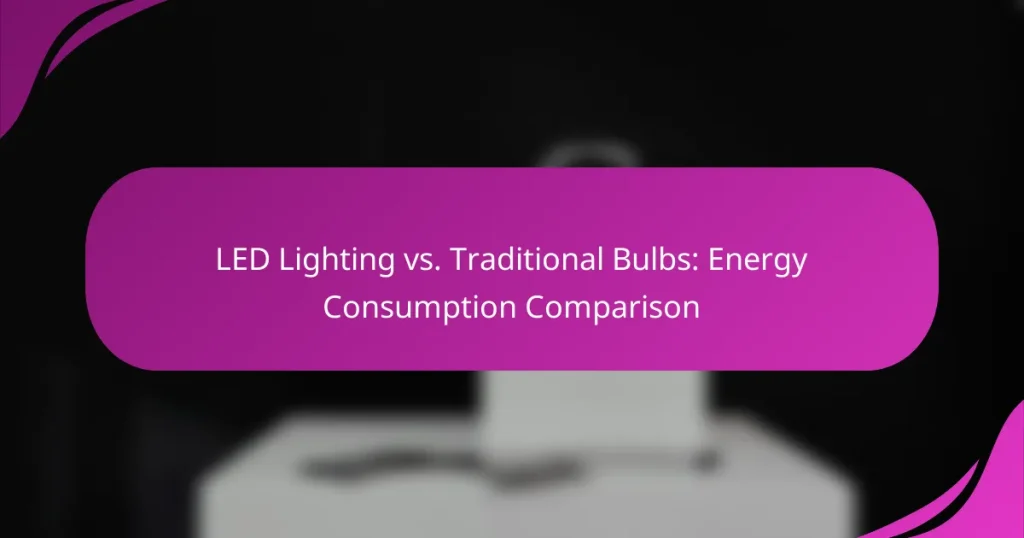When comparing LED lighting to traditional bulbs, the advantages of LEDs become clear, particularly in terms of energy consumption. LEDs use significantly less electricity while providing the same light output, leading to lower energy bills and a smaller environmental footprint. This efficiency not only saves money but also contributes to a reduction in greenhouse gas emissions and reliance on fossil fuels.
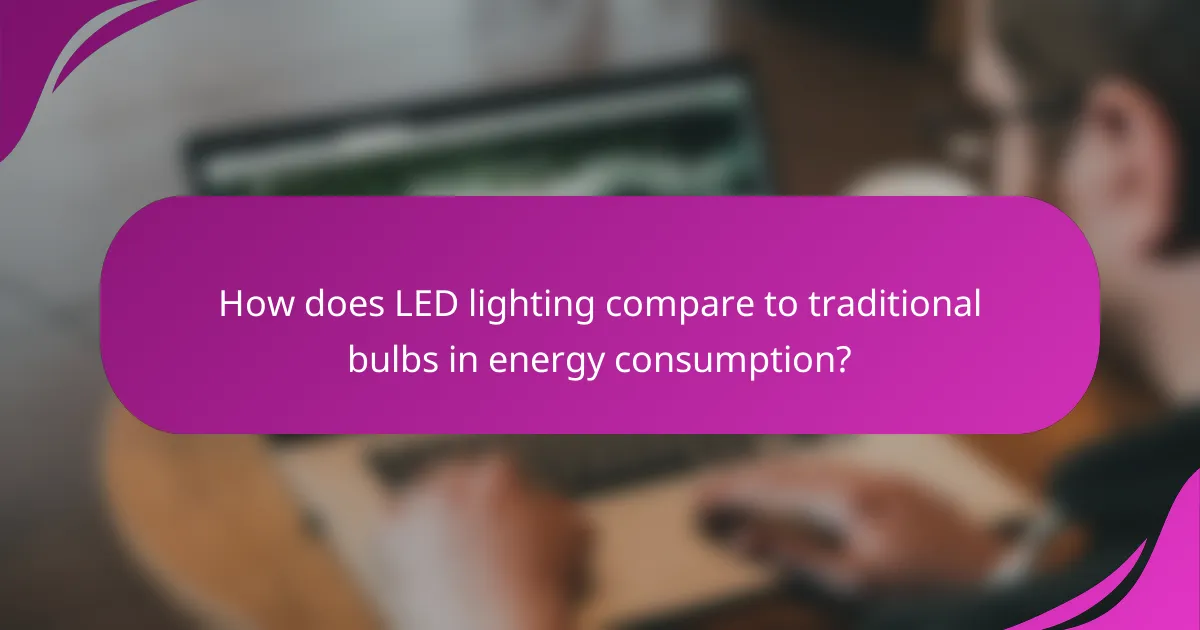
How does LED lighting compare to traditional bulbs in energy consumption?
LED lighting significantly outperforms traditional bulbs in energy consumption, using considerably less electricity for the same amount of light output. This efficiency translates into lower energy bills and a reduced environmental impact.
LED bulbs use up to 80% less energy
LED bulbs are designed to be highly efficient, consuming up to 80% less energy than their incandescent counterparts. For example, a typical LED bulb that produces around 800 lumens may only require about 10-12 watts, while an incandescent bulb would need approximately 60 watts to achieve the same brightness.
This remarkable energy efficiency not only reduces electricity costs but also contributes to a longer lifespan for LED bulbs, often lasting 15,000 to 25,000 hours compared to just 1,000 hours for traditional bulbs. This means fewer replacements and less waste over time.
Traditional bulbs have higher wattage requirements
Traditional incandescent bulbs have higher wattage requirements, which leads to increased energy consumption. For instance, a standard 100-watt incandescent bulb produces about 1600 lumens, while an LED bulb can achieve the same brightness with only 14-16 watts.
As a result, households and businesses using traditional bulbs face higher electricity bills and a larger carbon footprint. Transitioning to LED lighting can significantly mitigate these issues, making it a practical choice for energy-conscious consumers.
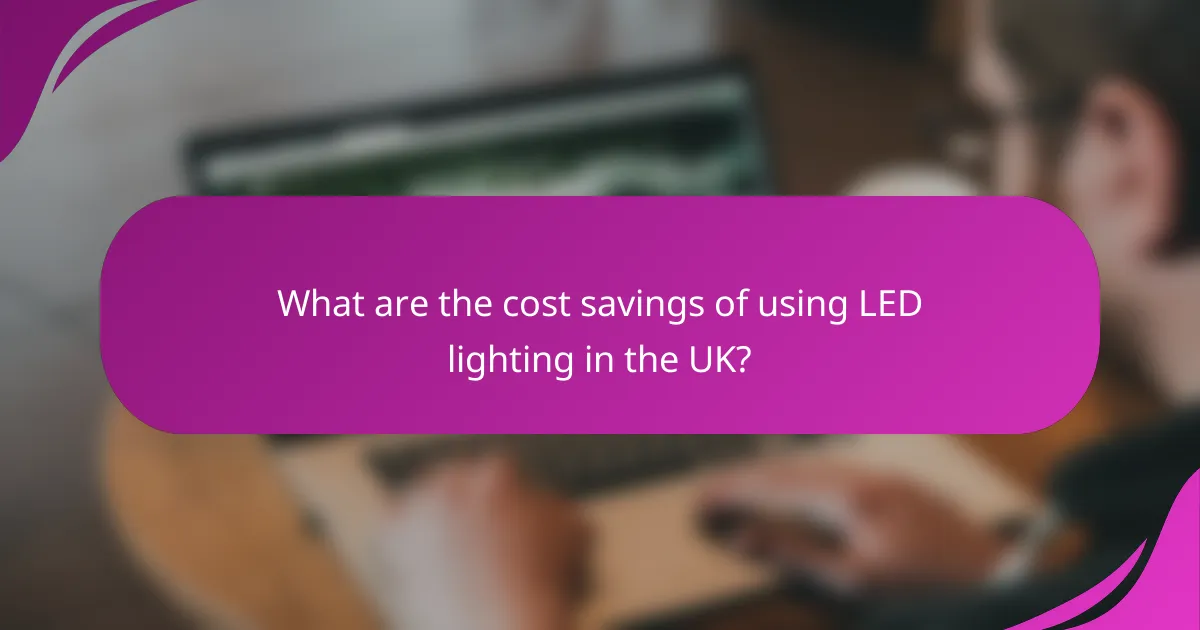
What are the cost savings of using LED lighting in the UK?
Using LED lighting in the UK can lead to significant cost savings on energy bills and maintenance. LEDs consume less electricity compared to traditional bulbs, translating into lower monthly expenses and reduced environmental impact.
Lower electricity bills with LED usage
LED lights are highly energy-efficient, using up to 80% less electricity than incandescent bulbs. For example, if a household switches from traditional bulbs to LEDs, they could save between £50 to £100 annually on electricity costs, depending on usage.
Additionally, the UK government encourages the adoption of energy-efficient lighting through various initiatives, which can further enhance savings. By replacing old bulbs with LEDs, consumers not only benefit from lower bills but also contribute to national energy conservation efforts.
Longer lifespan reduces replacement costs
LED bulbs typically last significantly longer than traditional bulbs, often exceeding 15,000 hours compared to just 1,000 hours for incandescent options. This extended lifespan means fewer replacements, which can save households around £10 to £20 per bulb over time.
Moreover, the reduced frequency of bulb replacements minimizes the hassle and cost associated with purchasing new bulbs and disposing of old ones. Investing in LED lighting is not just about immediate savings; it also provides long-term financial benefits through decreased maintenance and replacement needs.
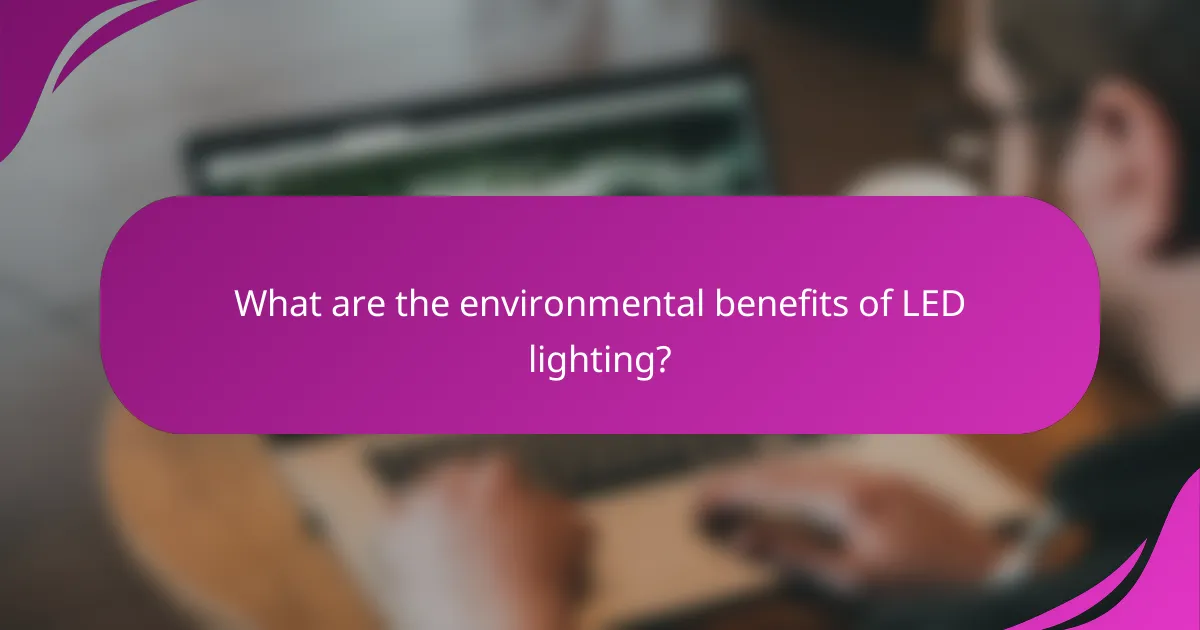
What are the environmental benefits of LED lighting?
LED lighting offers significant environmental benefits, primarily through reduced energy consumption and lower greenhouse gas emissions. By using less electricity than traditional bulbs, LEDs contribute to a decrease in fossil fuel reliance and pollution.
Reduced carbon footprint
Switching to LED lighting can substantially lower your carbon footprint. LEDs consume up to 80% less energy than incandescent bulbs, which means that less electricity is generated from fossil fuels, leading to fewer carbon emissions. For example, replacing a single 60-watt incandescent bulb with a 10-watt LED can save around 400 kilograms of CO2 over its lifetime.
In addition to individual savings, widespread adoption of LED technology can lead to a significant reduction in overall energy demand, which can help mitigate climate change impacts. Many countries are encouraging this shift through incentives and regulations.
Less hazardous waste compared to traditional bulbs
LEDs are less harmful to the environment than traditional bulbs because they contain no toxic materials like mercury, which is found in compact fluorescent lamps (CFLs). This means that when LEDs reach the end of their life, they produce less hazardous waste that requires special disposal methods.
Furthermore, the longer lifespan of LEDs—often lasting 15,000 to 50,000 hours—means fewer bulbs are disposed of over time. This longevity reduces the frequency of replacements and the associated waste, making LEDs a more sustainable choice in the long run.
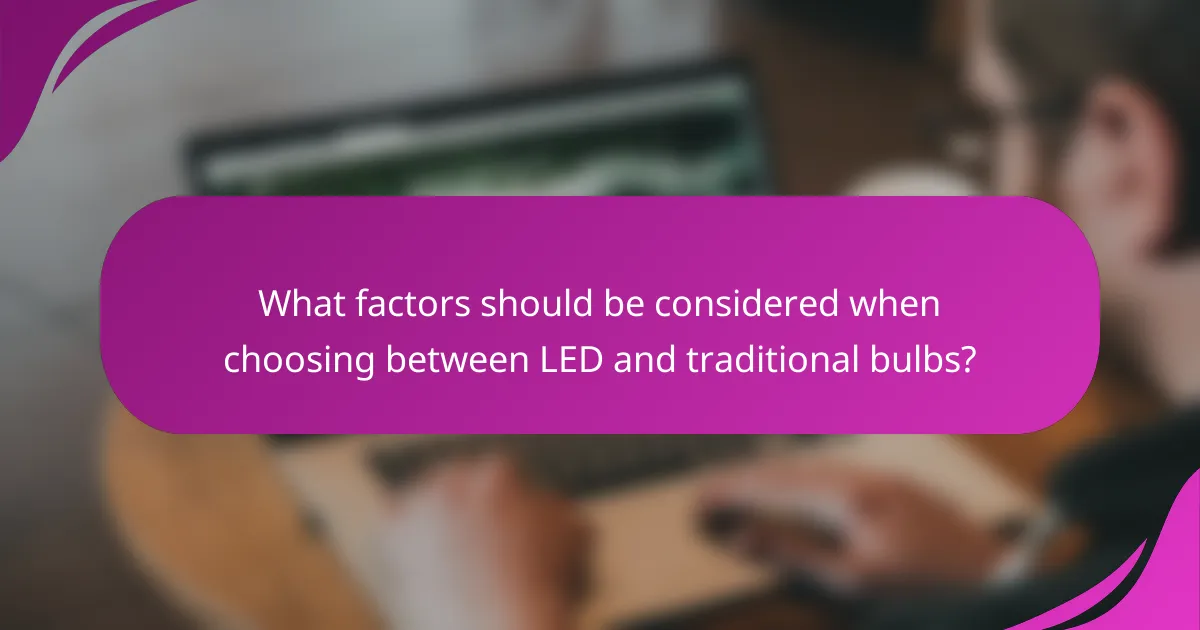
What factors should be considered when choosing between LED and traditional bulbs?
When choosing between LED and traditional bulbs, consider factors such as initial purchase price, energy efficiency, lifespan, and environmental impact. These elements will help you determine the best option for your needs and budget.
Initial purchase price
The initial purchase price of LED bulbs is typically higher than that of traditional incandescent bulbs. While a standard incandescent bulb may cost a few dollars, an LED bulb can range from several dollars to over twenty dollars, depending on the brand and features.
However, it’s crucial to view this cost in the context of long-term savings. Although LEDs require a larger upfront investment, their longevity and energy efficiency often lead to lower overall costs over time.
Energy efficiency ratings
LED bulbs are significantly more energy-efficient than traditional bulbs. An LED bulb can use about 75% less energy than an incandescent bulb to produce the same amount of light. This efficiency translates into lower electricity bills and reduced environmental impact.
When comparing energy efficiency ratings, look for the lumens per watt (lm/W) metric. LEDs typically offer higher lumens per watt, making them a more sustainable choice. For example, a 10-watt LED bulb can produce the same brightness as a 60-watt incandescent bulb, showcasing a substantial difference in energy consumption.
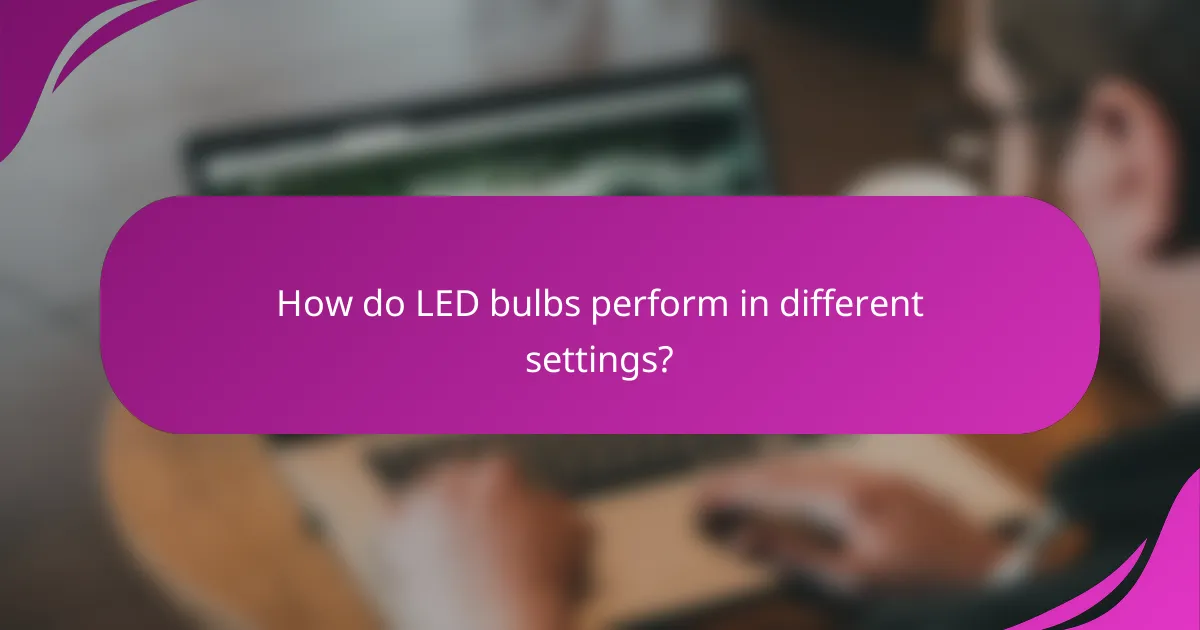
How do LED bulbs perform in different settings?
LED bulbs excel in various settings due to their energy efficiency, longevity, and versatility. They consume significantly less energy compared to traditional incandescent bulbs, making them suitable for both indoor and outdoor applications.
Better performance in outdoor lighting
LED bulbs are particularly effective for outdoor lighting because they provide bright illumination while consuming minimal energy. Their durability and resistance to weather conditions make them ideal for streetlights, garden lights, and security lighting.
For instance, LED streetlights can reduce energy consumption by up to 50% compared to traditional sodium vapor lamps. Additionally, their long lifespan means less frequent replacements, which is beneficial for municipal budgets.
Ideal for residential and commercial applications
In residential settings, LED bulbs offer significant savings on electricity bills, often reducing costs by 70% compared to incandescent bulbs. They are available in various color temperatures, allowing homeowners to choose the ambiance they desire.
For commercial applications, such as offices and retail spaces, LED lighting enhances visibility and can improve employee productivity. Businesses can also benefit from government incentives for switching to energy-efficient lighting, further offsetting initial costs.

What are the latest trends in LED lighting technology?
Recent trends in LED lighting technology focus on enhanced connectivity, improved color temperature, and brightness control. These advancements not only increase energy efficiency but also provide users with greater flexibility and customization in their lighting solutions.
Smart LED bulbs with connectivity features
Smart LED bulbs are designed to connect to home networks, allowing users to control lighting remotely via smartphones or voice-activated devices. These bulbs often support integration with smart home systems, enabling automation based on schedules or environmental conditions.
When choosing smart LED bulbs, consider compatibility with existing devices and platforms, such as Amazon Alexa or Google Assistant. Many models also offer features like dimming and color changing, enhancing the user experience and energy savings.
Advancements in color temperature and brightness control
Modern LED lighting technology allows for precise control over color temperature and brightness, enabling users to create the desired ambiance in any space. Options typically range from warm white to cool daylight, catering to different activities and preferences.
Adjustable brightness levels can help reduce energy consumption, as users can lower the intensity when full brightness is unnecessary. Look for bulbs that offer a wide range of color temperatures and smooth dimming capabilities to maximize flexibility and comfort in your lighting choices.

What is the future of lighting in the UK?
The future of lighting in the UK is increasingly leaning towards energy-efficient solutions such as LED technology. As regulations tighten and sustainability becomes a priority, the shift from traditional bulbs to LEDs is expected to accelerate, driven by their lower energy consumption and longer lifespan.
Energy Efficiency of LED Lighting
LED lighting is significantly more energy-efficient compared to traditional incandescent or halogen bulbs. While incandescent bulbs convert only about 10% of their energy into light, LEDs can convert up to 90% of their energy, resulting in lower electricity bills and reduced carbon footprints.
For instance, replacing a 60-watt incandescent bulb with a 10-watt LED can save around 50-70% on energy costs. This efficiency translates into substantial savings over time, especially in commercial settings where lighting is used extensively.
Longevity and Maintenance Costs
LED bulbs typically last much longer than traditional bulbs, often exceeding 15,000 hours compared to around 1,000 hours for incandescent bulbs. This longevity means fewer replacements and lower maintenance costs over time.
In practical terms, using LED lighting can reduce the frequency of bulb changes, which is particularly beneficial in hard-to-reach fixtures. This can save both time and money, making LEDs a more convenient choice for homeowners and businesses alike.
Environmental Impact
The environmental benefits of switching to LED lighting are significant. LEDs consume less energy, which reduces the demand on power plants and decreases greenhouse gas emissions. Additionally, they contain no hazardous materials like mercury, which is found in some traditional bulbs.
By choosing LED lighting, consumers can contribute to a more sustainable future. The UK government encourages this transition through various initiatives and incentives aimed at reducing energy consumption and promoting greener technologies.
